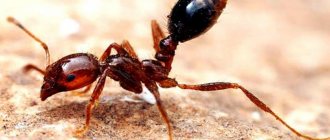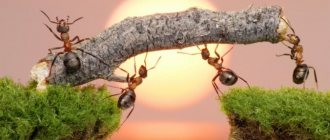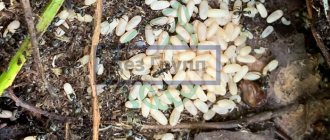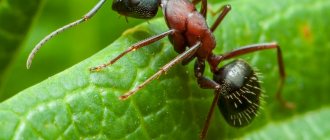Species of ants living alone are unknown to science. All of them are kept by large families that last for many years. The inhabitants of each nest are related to each other, so from a biological point of view it is precisely a family. But from the standpoint of our human ideas, an anthill rather resembles a city, the population of which is divided into castes and strictly organized.
By the way, 10 thousand species of ants are currently known; they inhabit all continents of the Earth (except Antarctica).
Winged
If you see an ant with wings, then this is a representative of one of two special and small ant classes.
The minority in ant society is the caste of male ants. Their life is short, and their fate is unenviable - after mating with a female, the “macho ants” die.
The second caste is oviparous females (“queens”). There are not many of them either. Depending on the species, each anthill is home to from one to several hundred “queens.” “Rulers” live a long time - with a successful combination of circumstances, each can reign for up to 20 years.
Question answer
Insect pests in the house: main types and methods of control. Infographics (09.20.2013)
Females and males are winged. During the only mating flight in her life, the queen may meet several partners. As a result of this peculiar orgy, she becomes a “machine” for the reproduction of ants for the rest of her life and will lay tens of thousands of fertilized eggs in the future. After mating, the female sheds her wings and is either accepted into an existing anthill, or she starts a new family.
Internal organization
From the inside, the anthill amazes with the thoughtfulness and well-functioning work of the builders. Inside, this structure is a collection of passages - an anthill, with many exits and various chambers. The structure goes deep underground, is divided into two parts and houses a whole colony of hardworking inhabitants.
Insects spend most of their time in the upper tier and live here during the warm season. The chambers are well heated, and all conditions for raising offspring are created here. The lower part, which goes one and a half to two meters underground, has similar structures. It is designed for wintering insects that wait out cold weather underground and store food reserves.
Each part is divided into chambers that perform specific functions:
- Queen's room. The queen lives in it and lays eggs there. It is looked after by worker ants who lay eggs.
- Egg storage. The ants bring eggs here and ensure that conditions are provided for their development.
- Chamber for larvae. The hatched ants are shaped like worms and are characterized by their insatiable gluttony. They are placed several in one chamber and provided with food.
- The anthill structure also includes a food storage room. Moreover, there are separate rooms for grains, seeds, insect parts, and aphids.
- Garbage storage warehouse.
- Wintering room.
The chambers are connected by numerous passages, which are carefully guarded by soldier ants. With the onset of cold weather or the approach of danger, the openings of the ant house close.
Do ants have enemies and who destroys anthills in the forest? These insects have plenty of enemies. If in the city even pets - dogs or cats - can cause damage to an anthill, then in the forest bears pose a great danger to them. The clubfooted owner of the taiga uses his clawed paw to rake anthills to feast on larvae and ants. Hedgehogs, like mice, will not refuse a light snack if they encounter an anthill on their way.
Many of us have known about the structure of ant homes since school, and most know that they cannot be destroyed. Unfortunately, the reality is different.
Myrmecologists are engaged in serious research into the life of these hardworking insects.
"Proletariat"
The vast majority of the population of any anthill is the third caste - workers. Although ants are usually called in the masculine gender, they are all physiologically underdeveloped sterile females. They do not have wings, and their ovipositors are turned into stings - personal military weapons designed for defense and attack.
Workers provide the livelihood for the family. They build and protect the nest, provide the anthill with food, clean and feed the “queens” and “children,” protect the feeding area, ensure the flight of winged individuals, etc. The number of workers in the family varies - from several tens to hundreds of thousands and even 10– 15 million. The life expectancy of six-legged proletarians is from 4 to 7 years.
Photo: Roman Prokhorov
Caste division
Most of the colony consists of worker ants. Half of them provide coziness and comfortable living inside the building, the other takes care of food supplies and is engaged in external construction of the house. The hierarchy is headed by the female, who is more often called the queen or queen. It is she who, having been fertilized at a young age, produces offspring throughout her life and finds a place for an anthill.
After two weeks, ants appear, usually a worker clan. It is they who begin the construction. A small part of the colony consists of young males. Their fate is unenviable - after the female is fertilized, they die within two weeks.
Career ladder
Typically, a worker ant changes several professions during its life. The young are busy inside the nest: they look after the female (“retinue”), children, that is, eggs and larvae (“nannies”), and older workers (“grooms”), clean and repair underground chambers and passages (“repairmen”), store water (“barrel ants”).
After working for 1–3 years and gaining experience and qualifications, the ants are transferred to the reserve, where they can rest a little and allow new generations of young workers to take care of themselves. Approximately a third of the “proletariat” is in reserve, but they must be constantly prepared to deal with the consequences of accidents and natural disasters.
Question answer
How to get rid of ants in garden beds and greenhouses?
The ranks of “employees” working outside the nest are also replenished from the reserve - builders, foragers (scouts, hunters or food gatherers), water carriers, orderlies, guards, and experienced veteran observers.
How is the inside of an anthill arranged, what is its structure?
Sectional diagram of the structure of an anthill with the designation of functional chambers.
Structure of an ant colony. Most often, dome-shaped anthills are found, but sometimes ants prefer to settle in rotten tree trunks or large old stumps. In regions with extremely hot climates (for example, deserts), insects build their homes exclusively underground.
The inside of an anthill looks different, but the structure of the allocation and organization of specialized chambers is characteristic of any nest of ants.
Indoor cameras can be divided into the following categories:
- “ solarium ” - a small chamber under the very dome of the anthill, insects bask in it in the warm season;
- “ wintering chamber ” - located below the soil level, in which the ants survive the cold, plunging into suspended animation;
- “royal chamber” or “ queen’s room ” - here is the queen who lays eggs;
- “grain barn” or “ granary ” - intended for storing grass and tree seeds;
- “kindergarten” or “ nursery ” - chambers in which eggs mature and ant larvae are born;
- “meat pantry” or “ refrigerator ” - they store the corpses of insects, worms and caterpillars.
- “cow barn” - where ants contain and raise aphids.
- " graveyard " is a place where waste and deceased individuals are found. It is significantly removed from the anthill, since the ants understand that corpses and waste are a source of disease and infection;
Each sexually mature insect has a clear idea of the location of the chambers. An increase in the anthill leads to the expansion of existing chambers and the construction of new premises.
The depth of the anthill underground can reach up to 2 meters and has an organized complex structure. And the above-ground part can be from 30 cm to 2 m high. All this looks like a huge city.
The depth and structure of an ordinary anthill are amazing. The insides of this amazing structure consist of large fragments of branches. Between them there are many galleries leading to individual chambers, which is a rather complex device.
The height of the structure varies from 30 cm to 2 m, the underground part most often exceeds the above-ground area. The outer covering consists of small twigs, pine needles, grains of sand and reliably protects ants from dampness, wind and cold. The structure of the underground anthill of the garden ant is similar to the forest one, but on the surface it is only a small sandy mound.
Here are a few photos of what a large forest anthill looks like:
The underground part, as a rule, is comparable, and often exceeds the above-ground part in size. In places where there are large reserves of resources for ants (water, cereals, insects of other species), dwellings can reach gigantic sizes. In some cases, the population of a colony can exceed, imagine, 1.5 million individuals.
The anthill is arranged in an interesting way: up to a third of the working ants continuously move needles and branches! Why are they doing this?
The anthill is designed in such a way that a positive temperature (26-29 degrees Celsius) is constantly maintained inside, which is very important for ants. For this purpose, pine needles and branches from the lower layer of coating are transferred to the surface, ventilated and dried. This process is continuous, and approximately a third of the worker ants participate in it. Thanks to their efforts, favorable conditions are created for the development of larvae and the preservation of food supplies.
Vertical of power
In each anthill, a certain ratio of individuals of different groups is clearly maintained. This happens in several ways at once. The managerial decisions of the “queen” are of primary importance. They are conveyed to subordinates through various substances secreted by various glands of her body.
If there are many egg-laying females in the nest, then new winged individuals do not appear for a long time. But at certain moments, the ruling “queens” feel the approach of old age and stimulate the appearance of young “princesses” and their male partners. To achieve this, the females secrete a special liquid, which the “nannies” feed to a limited number of selected larvae. Each of them subsequently grows into a winged female or male, depending on the dose of “nectar” received.
After this, the following often happens: the same “nannies” who looked after the heirs from the moment they were born, without sentimentality, kick them out of their home.
It happens that there are too many larvae of future sexually mature males and females. Then the extra ones are simply eaten - the protein should not go to waste. On the other hand, if there is an overproduction of worker larvae in the nest, then this reduces the fertility of the “queens” for a certain time.
Photo: Shutterstock.com
Ants: general characteristics
Ants are insects that live in almost all corners of our planet, with the exception of Greenland and Antarctica, as well as some oceanic islands. They populated not only steppes and forests, but also deserts. There are 13.5 thousand species of ants, 300 of them are common in our country.
Ants belong to the order Hymenoptera, phylum of arthropods, class of insects, family of ants. These are social insects, clearly divided into three castes: males, females, and workers. These little hardworking creatures cannot live alone, so they always create colonies.
What's the harm?
Many species of ants are considered beneficial to humans, but two species - turf and garden ants (black and red) - cause harm to gardens and vegetable gardens. In particular, these insects use the sweet secretions of sucking pests as an additional (and sometimes the main) source of nutrition. For this reason, ants protect aphids, psyllids, scale insects and false scale insects from attacks by enemies, and contribute to their settlement and reproduction. And our plants are left with bloodless leaves, contaminated with sticky honeydew, which serves as a breeding ground for sooty fungi.
In addition, the inhabitants of anthills damage the roots, eat the seeds in the soil without leaving a trace, and gnaw on seedlings and seedlings with appetite.
Article on the topic
4 Best Ways to Control Ants
Physiological features
The body structure of these insects is divided into three parts, covered with a chitinous shell: the head, as well as the chest and abdomen connected by a thin waist. The eyes, which consist of many lenses, distinguish movement, but do not produce a clear image. Ants move with the help of six thin legs with claws at the ends, which allow the insect to climb upward.
The antennae, segmented, are located on the head. These are organs of touch that not only detect odors, but also feel the vibration of the soil and the movement of air currents. The structural features of the insect and the size of the ants depend on their species, as well as their status in the colony. On average it ranges from 1 mm to 3 cm.
The largest individuals in some species are females, in others their size is no larger than the size of working individuals. Females have wings that fall off after the mating season. The colors of ants can vary from black, red, yellow and brown to unusual green or bluish. Ants are difficult to classify, since twin species and numerous hybrids are common in nature. Only specialists can distinguish them by appearance.
Exterior view of the ant house
An anthill outwardly resembles a mountain of blades of grass, twigs, and pieces of soil, but in reality it is a well-organized dwelling, inside of which interesting life is in full swing. From above, the anthill structure is a cone-shaped mound with small openings-entrances. This shape is not accidental - it allows the anthill to be well warmed up by the sun, not to get wet when it rains, and to receive the necessary access to oxygen.
Over the years, the anthill grows to several meters in height. Raindrops that fall on the outer layer do not penetrate inside. The open entrances, which are guarded by a large army of soldiers, are ventilation shafts through which air constantly flows into the ant house. In the Tomsk region, scientists discovered a huge anthill 3 meters high and about 5 meters in diameter. Experts believe that this structure took about 20 years to build.











